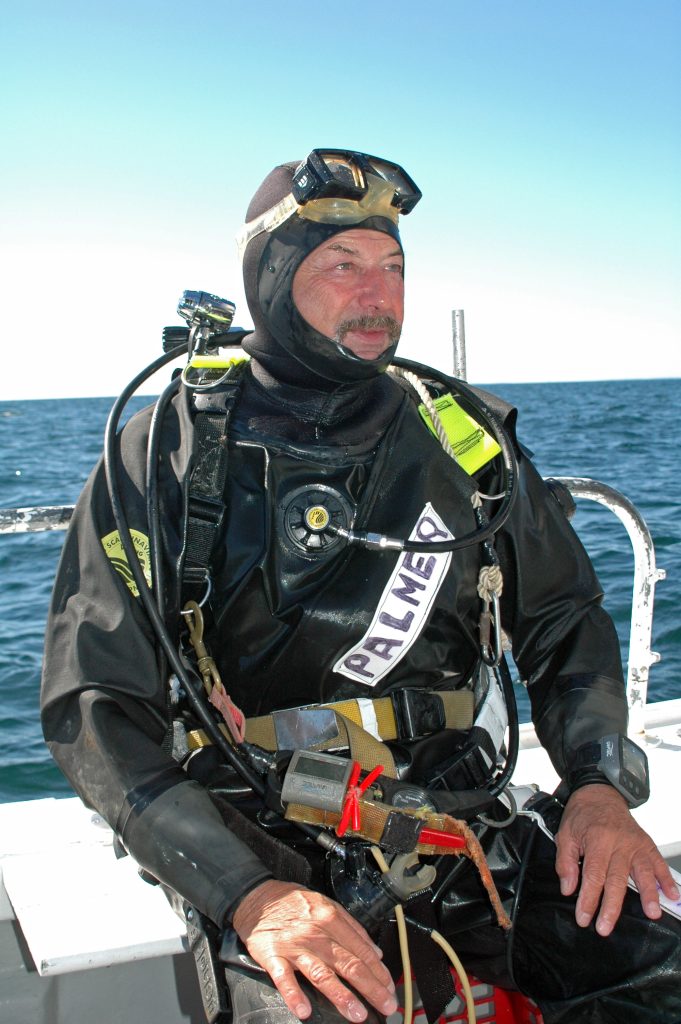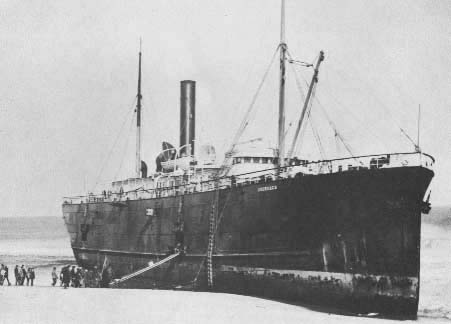The navigation markers on the Mystic River in Connecticut appear like apparitions out of the thick fog. They’re the only indication of where we’re going and where the channel is. The brightly colored screen of the chartplotter shows our position and heading. Fog has probably been the cause of more shipwrecks and deaths than any other reason. The most famous disaster caused by fog was the Titanic, the largest ship in the world at the time, which struck an iceberg with the loss of an estimated fifteen hundred people.
I’m on the bridge of the Thunderfish, Captain Bill Palmer’s 35-foot Bertram. Bill is a charter boat captain, wreck diver, and undersea explorer. Today we’re heading out to the well-known dive site of the steamship Onondaga on one of Watch Hill’s reefs. Without radar and GPS there is no way we would be leaving the harbor today.
The S.S.Onondaga was built in 1905 in Philadelphia by William Camp & Sons for the famous Clyde Steamship Company. The company ran a fleet of steamships connecting Philadelphia and other East Coast ports all named after Indian tribes. The Onondaga was typical of the steel-hulled passenger freighters of that time. Her principle dimensions were 275-feet in length, 40-foot beam, and 19-foot draft. Her gross tonnage was 2,696.

On her maiden voyage on June 16, 1905, she sailed from New York City to Charleston, South Carolina, then down to Jacksonville, Florida for loading. After stopping on the return trip to take on more cargo she arrived at Boston on June 27, thus ending her maiden voyage. The steamer carried a variety of general cargo from the southern ports, mostly lumber, cotton, naval stores, vegetables and fruit. Over the years the Onondaga had many close calls including the one pictured here in 1907. But she always managed to come through.
But her luck would run out on her last voyage. The Onondaga left Boston in the afternoon on June 27, 1918 carrying a large cargo consisting of large amounts of shoes, boots, leather, and mill products destined for Jacksonville via New York. On June 28, 1918 there was a fog similar to the one Bill and I are now experiencing. The ship was ordered to take the inside passage through Long Island Sound rather than the offshore route because of the threat of World War I German U-boats.
Bill explained what happened, “There was dense fog just like today. The captain of the Onondaga, W. H. Googins, heard the Watch Hill Lighthouse fog horn which he mistook for the horn at Race Rock. He tried to come on the inside of the rock which put him over Catomb Reef a half mile from the Watch Hill Lighthouse. It was almost 9:00 pm and most of the 35-man crew were asleep when suddenly a lookout spotted breakers. He raised the alarm and men poured out on deck as the ship hit the rocks damaging her bottom. The crew immediately took to the lifeboats as the ship started to take on water. The lifeboat carrying the captain was smashed to pieces injuring him in the process but he was pulled out of the water by the crew. Everyone on board made it to the shore where they were met by the local life-savers. By the time the Onondaga’s crew left Watch Hill the following day the Onondaga had rolled over and only the tips of her masts could be seen above the water. An attempt to refloat the vessel was unsuccessful and she was declared a total loss.”

Bill talked about the dive. “It’s a great dive for beginners because the bow is in only 35 feet of water and the stern in 55. The only thing is you have to dive at slack water otherwise the strong current on the reef can literally rip the mask right off your face. Also, if there is any swell the surge can push a diver up against the jagged steel plates of the hull but in good weather, at slack tide, it’s great. Visibility varies depending on the time of year and the amount of plankton in the water. Generally, the visibility is between ten and fifteen feet. The stern of the ship is pretty much intact and you can see the propeller shaft sticking out. The rudder is also intact. I believe the propeller was blown off in the sixties. As you swim along the stern the hull sticks down into the sand. Next, you come to the boilers. After that, it flattens out and it’s like a giant junkyard. Cargo is spread everywhere. She was carrying assorted cargo including Model T tires, dishes, cups and saucers, perfume bottles, and shoes. She also might have been carrying Harley Davidson motorcycles. I’d like to find one of those.”The sun had burned off the fog as we reached the reef. I watch as Bill and the other diver put on their gear. Soon bubbles from their air tanks are the only traces of where they are. After a while two heads break the surface and reaching the boat Bill throws a long slimy object onto the rail. It looked like a giant eel. He chuckled and said it was a Model T tire, the rubber still flexible after a hundred years underwater.
The tide turned and the current started to run, time to go. Bill settles the boat on a course for the Mystic River. Watching the small triangle representing our position move across the chartplotter I think about Captain Googins and how modern navigation technology would have saved his ship and so many others.
